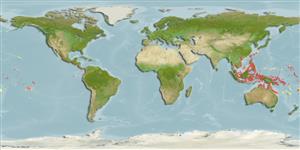>
Gobiiformes (Gobies) >
Gobiidae (Gobies) > Gobionellinae
Etymology: Hemigobius: Greek, hemi = half + Latin, gobius = gudgeon (Ref. 45335).
Eponymy: Dr Jan van der Hoeven (1801–1868) was a Dutch zoologist and physician who took degrees in physics (1822) and medicine (1824) at Leiden University, then practised as a physician (1824–1826). [...] (Ref. 128868), visit book page.
More on author: Bleeker.
Environment: milieu / climate zone / depth range / distribution range
Ecologia
marino; acqua dolce; salmastro demersale; amfidromo (Ref. 46888); distribuzione batimetrica 0 - 5 m (Ref. 86942). Tropical
Western Pacific: Thailand, Hong Kong, Malaysia, Singapore, Philippines, Borneo, New Guinea and northern Australia.
Size / Peso / Age
Maturity: Lm ? range ? - ? cm
Max length : 6.0 cm TL maschio/sesso non determinato; (Ref. 7050)
Short description
Chiavi di identificazione | Morfologia | Morfometria
Spine dorsali (totale) : 7; Raggi dorsali molli (totale) : 7 - 8; Spine anali: 1; Raggi anali molli: 7 - 9; Vertebre: 26 - 27. Body robust, compressed, with rounded somewhat depressed head, snout rounded and overhanging upper lip; longitudinal scales 27-32; anteriormost predorsal scale largest, 8-10 scales, extending close up behind eyes; mouth enlarged in males; scales on body ctenoid; first dorsal fin low, rounded, with no filamentous spines; body greyish to brownish with six diagonal blackish bars across sides, marbled to ocellate black spot on caudal base, roughly vertical black spot on caudal base, roughly vertical black line on opercle extending to underneath head (Ref. 44011). Caudal fin rounded (Ref. 44011).
Inhabit mangrove estuaries and streams, usually under leaf litter and detritus (Ref. 44011).
Life cycle and mating behavior
Maturità | Riproduzione | Deposizione | Uova | Fecundity | Larve
Larson, H.K., 1999. A review of the mangrove goby genus Hemigobius (Gobioidei, Gobiidae, Gobionellinae). Beagle, Rec. Mus. Art Galler. North.Territ.15:23-42. (Ref. 44011)
IUCN Red List Status (Ref. 130435: Version 2024-2)
Threat to humans
Harmless
Human uses
Pesca: di nessun interesse
Strumenti
Special reports
Download XML
Fonti Internet
Estimates based on models
Preferred temperature (Ref.
123201): 26.2 - 29.3, mean 28.7 °C (based on 1931 cells).
Phylogenetic diversity index (Ref.
82804): PD
50 = 0.7500 [Uniqueness, from 0.5 = low to 2.0 = high].
Bayesian length-weight: a=0.00724 (0.00338 - 0.01553), b=3.05 (2.87 - 3.23), in cm total length, based on LWR estimates for this (Sub)family-body shape (Ref.
93245).
Trophic level (Ref.
69278): 3.3 ±0.4 se; based on size and trophs of closest relatives
Resilienza (Ref.
120179): Alto, tempo minimo di raddoppiamento della popolazione meno di 15 mesi (Preliminary K or Fecundity.).
Fishing Vulnerability (Ref.
59153): Low vulnerability (10 of 100).
